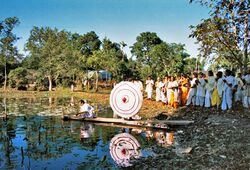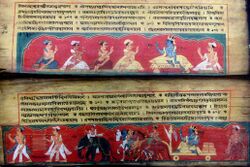Religion:Dakhinpat Satra
| Dakshinpat Satra | |
|---|---|
 | |
| Religion | |
| Affiliation | Hinduism |
| District | Majuli |
| Deity | Jadhav Rai |
| Festivals | Raasleela |
| Location | |
| State | Assam |
| Country | India |
| Architecture | |
| Type | Assamese |
| Creator | Banamalidev |
| Completed | 1654 |
| Expression error: Unexpected < operator. | |
| Inscriptions | Assamese Brajavali |
Dakhinpat Satra, situated in the south-east corner of Majuli. It is one of Assam's most well-renowned and principle monastic Satra, established by Banamali Dev Goswami in 1654 under the patronization of Ahom King Jayadhwaj Singha. This Satra particularly belongs to Brahmasamhati sect, founded by Damodardev.
Satra
Banamali Devgoswami, a prominent disciple of Vamshigopal, established the Satra under the patronization of Ahom King Jayadhwaj Singha, who endowed extensive land grants and provisions for the smooth functioning of this Satra.[1] The prestige and affluence of the Satra were further enhanced by Chakradhwaj Singha, Udayaditya Singha and Sulikpha who are considered to be the disciples of Banamalidev.[2]
The main idol worshipped here is of Lord Jadav Rai.[3] Dakhinpat Satra played a very important role in political and administrative affairs during the Ahom reign. It is also one of the Chari-Raj Satra, other viz., Auniati, Garmur, and Kuruabahi. The Satra belongs to the Brahmasamhati sect, founded by Damodardev and admitted some brahminical rites along with general devotional practices and took a rigid view on caste distinction.[4]
The monks of the Satra are called Bhakats and lead a life of celibacy. The head of the Satra is called Sattradhikar, next to him is the Deka-Adhikar or the successor to the Satradhikar. All pontiffs of the Dakhinpat Satra belong to the lineage of Banamalidev (1576-1683). Therefore one brother of the Satradhikar is allowed to marry and continue their lineage.[5]
Culture
Dakhinpat Satra is well known for its annual Rass festival and Brahmaputra Puja, held after every twelve years. Performance of many other Sankari culture is performed regularly within the Satra premise. The Satra has a collection of hundreds of manuscripts, many being illustrated with paintings.[6] It also possesses a large number of valuable artifacts from the Ahom reign.[7][8]
List of Satradhikars
- Banamali Devgoswami
- Ram Devgoswami
- Krishna Devgoswami
- Aatma Devgoswami
- Kam Devgoswami
- Saha Devgoswami
- Ronti Devgoswami
- Bishnu Devgoswami
- Bibhu Devgoswami
- Bashu Devgoswami
- Shuva Devgoswami
- Nara Devgoswami
- Narayan Devgoswami
- Hari Devgoswami
- Ramananda Devgoswami
- Nanigopal Devgoswami (present–)
Notes
- ↑ "The King's zeal for the new religion grew more and more, and he brought Vauamali Deva, a learned Vaisnava scholar from the court of the Koch king, Prana Narain for teaching the tenets of the religion to his subjects"(Nath 1978:138)
- ↑ (Sarma 1966:81)
- ↑ (Choudhury 2018:72)
- ↑ (Shin 2017:247–249)
- ↑ (Choudhury 2018:76)
- ↑ "India, Manuscripts of the Dakhinpat Satra (Monastry) of Majuli" (in en). https://cultureincrisis.org/projects/india-manuscripts-of-the-dakhinpat-satra-monastry-of-majuli.
- ↑ Staff Reporter (2010-09-15). "Strong security needed to protect Dakhinpat artefacts: Shiela Bora" (in en). https://assamtribune.com/strong-security-needed-to-protect-dakhinpat-artefacts-shiela-bora.
- ↑ Staff Correspondent (2010-09-15). "CM lays foundation stone of museum at Dakhinpat Satra" (in en). https://assamtribune.com/cm-lays-foundation-stone-of-museum-at-dakhinpat-satra.
References
- Sarma, Satyendranath (1966), The Neo-Vaiṣṇavite Movement and the Satra Institution of Assam, Gauhati University: Department of Publication
- Cantlie, Audrey (1984), The Assamese Religion, Caste and Sect in an Indian Village, Taylor & Francis
- Choudhury, Sudeshna (10 March 2018), "Heritage culture of majuli with special reference to dakhinpat sattra", University (Gauhati University), https://shodhganga.inflibnet.ac.in/handle/10603/228968
- Nath, Rajmohan (1978), The Back-ground of Assamese Culture, Assam
- Shin, Jae-Eun (2017), "Transition of Satra from a Venue of Bhakti Movement to the Orthodox Brahmanical Institution", in Ota, Nobuhiro, Clustering and Connections in Pre-Modern South Asian Society, Tokyo: Tokyo University of Foreign Studies, pp. 237–257
External links
- Dakhinpat Satra A Cultural & Religious Monastery Of Majuli
 |



